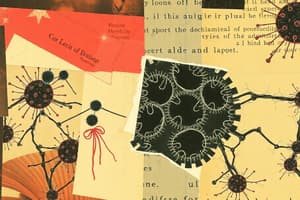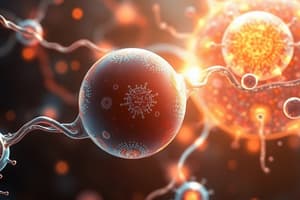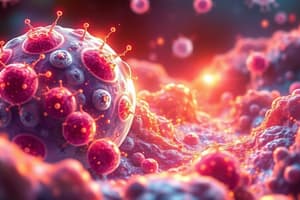Podcast
Questions and Answers
What triggers bioluminescence in Vibrio fischeri?
What triggers bioluminescence in Vibrio fischeri?
- High levels of carbon dioxide in the environment
- Absence of nutrients
- Binding of autoinducers to luxR receptor proteins (correct)
- Release of hormones from other cells
Which of the following best describes quorum sensing?
Which of the following best describes quorum sensing?
- Communication between cells through direct contact
- Signaling that occurs only in animals
- A process that only occurs in bacteria that do not produce autoinducers
- Chemical signaling based on the population density of cells (correct)
What role do calcium ions play in cellular signaling?
What role do calcium ions play in cellular signaling?
- They inhibit the synthesis of proteins
- They function as secondary messengers (correct)
- They only transport signals across the synapse
- They act as primary messengers
Which type of hormone is insulin classified as?
Which type of hormone is insulin classified as?
What is the primary function of neurotransmitters?
What is the primary function of neurotransmitters?
Which of the following is an example of a cytokine?
Which of the following is an example of a cytokine?
What is a characteristic feature of amine hormones?
What is a characteristic feature of amine hormones?
How do hormones typically reach their target cells?
How do hormones typically reach their target cells?
What role does the sodium potassium pump play in neurons?
What role does the sodium potassium pump play in neurons?
What is the resting potential of a neuron at equilibrium?
What is the resting potential of a neuron at equilibrium?
How many sodium ions are transported out of the cell during one cycle of the sodium potassium pump?
How many sodium ions are transported out of the cell during one cycle of the sodium potassium pump?
What initiates the conformational change in the sodium potassium pump?
What initiates the conformational change in the sodium potassium pump?
What is the function of sodium-dependent glucose cotransporters?
What is the function of sodium-dependent glucose cotransporters?
What happens to sodium ions during the process of glucose transport into epithelial cells?
What happens to sodium ions during the process of glucose transport into epithelial cells?
What is the energy source required for the sodium potassium pump to function?
What is the energy source required for the sodium potassium pump to function?
What happens to potassium ions once they bind to the sodium potassium pump?
What happens to potassium ions once they bind to the sodium potassium pump?
How does facilitated diffusion differ from active transport in glucose transport mechanisms?
How does facilitated diffusion differ from active transport in glucose transport mechanisms?
What causes the sodium-dependent glucose cotransport protein to change shape?
What causes the sodium-dependent glucose cotransport protein to change shape?
What is the primary role of GPCR proteins in cell signaling?
What is the primary role of GPCR proteins in cell signaling?
Which of the following describes the action of insulin in the body?
Which of the following describes the action of insulin in the body?
What differentiates steroid hormones like testosterone from peptide hormones like epinephrine?
What differentiates steroid hormones like testosterone from peptide hormones like epinephrine?
What mechanism is illustrated by the role of oxytocin during childbirth?
What mechanism is illustrated by the role of oxytocin during childbirth?
Which type of neurotransmitter is characterized as chains of amino acids?
Which type of neurotransmitter is characterized as chains of amino acids?
What initiates the cascade of reactions within a cell following the binding of a signaling chemical to a protein receptor?
What initiates the cascade of reactions within a cell following the binding of a signaling chemical to a protein receptor?
How does progesterone primarily act in the body after ovulation?
How does progesterone primarily act in the body after ovulation?
What is the function of nitric oxide (NO) as a neurotransmitter?
What is the function of nitric oxide (NO) as a neurotransmitter?
What is the significance of the hydrophobic section of transmembrane receptor proteins?
What is the significance of the hydrophobic section of transmembrane receptor proteins?
What occurs when an extracellular ligand binds to a GPCR?
What occurs when an extracellular ligand binds to a GPCR?
Which type of receptors are known to directly influence gene transcription?
Which type of receptors are known to directly influence gene transcription?
What defines negative feedback in physiological systems?
What defines negative feedback in physiological systems?
What crucial role do tyrosine kinase receptors play in cellular processes?
What crucial role do tyrosine kinase receptors play in cellular processes?
Which mechanism allows oestradiol to affect the secretion of gonadotropin-releasing hormones?
Which mechanism allows oestradiol to affect the secretion of gonadotropin-releasing hormones?
Flashcards
Quorum Sensing
Quorum Sensing
Cell-to-cell communication based on population density in bacteria.
Autoinducers
Autoinducers
Chemical messengers produced and released by bacteria during quorum sensing.
Protein Receptors
Protein Receptors
Binding sites on cells with specific shapes for signals.
Hormones
Hormones
Signup and view all the flashcards
Neurotransmitters
Neurotransmitters
Signup and view all the flashcards
Cytokines
Cytokines
Signup and view all the flashcards
Secondary Messengers
Secondary Messengers
Signup and view all the flashcards
Epinephrine
Epinephrine
Signup and view all the flashcards
Resting Potential
Resting Potential
Signup and view all the flashcards
Amino Acid Neurotransmitters
Amino Acid Neurotransmitters
Signup and view all the flashcards
Sodium-Potassium pump
Sodium-Potassium pump
Signup and view all the flashcards
Peptide Neurotransmitters
Peptide Neurotransmitters
Signup and view all the flashcards
Amine Neurotransmitters
Amine Neurotransmitters
Signup and view all the flashcards
Sodium-Potassium Pump Function
Sodium-Potassium Pump Function
Signup and view all the flashcards
Facilitated Diffusion
Facilitated Diffusion
Signup and view all the flashcards
Nitrous Oxide Neurotransmitters
Nitrous Oxide Neurotransmitters
Signup and view all the flashcards
Sodium-Dependent Glucose Cotransporters
Sodium-Dependent Glucose Cotransporters
Signup and view all the flashcards
Natural Selection in Signaling
Natural Selection in Signaling
Signup and view all the flashcards
Indirect Active Transport
Indirect Active Transport
Signup and view all the flashcards
Diversity of Signaling Roles
Diversity of Signaling Roles
Signup and view all the flashcards
Cotransport
Cotransport
Signup and view all the flashcards
Transmembrane Receptor Protein
Transmembrane Receptor Protein
Signup and view all the flashcards
Active Transport
Active Transport
Signup and view all the flashcards
Intracellular Receptor Protein
Intracellular Receptor Protein
Signup and view all the flashcards
Transduction Pathway Initiation
Transduction Pathway Initiation
Signup and view all the flashcards
Concentration Gradient
Concentration Gradient
Signup and view all the flashcards
ATP
ATP
Signup and view all the flashcards
ACH Receptor
ACH Receptor
Signup and view all the flashcards
G Protein
G Protein
Signup and view all the flashcards
G Protein Activation
G Protein Activation
Signup and view all the flashcards
Epinephrine's Action Mechanism
Epinephrine's Action Mechanism
Signup and view all the flashcards
Tyrosine Kinase Receptors
Tyrosine Kinase Receptors
Signup and view all the flashcards
Insulin's Action
Insulin's Action
Signup and view all the flashcards
Study Notes
Cell Signaling Mechanisms
- Ligands are specific signaling chemicals that bind to receptors, initiating a response.
- Protein receptors have specific shapes (binding pockets) to allow ligands to bind.
- Quorum sensing is a form of cell-to-cell communication based on population density.
- Quorum refers to a group or population of similar organisms.
- Vibrio fischeri are bioluminescent bacteria, only emitting light when their population density reaches a critical level, triggering quorum sensing. They release autoinducers, chemical messengers, into their environment. Increasing population density leads to higher autoinducer concentrations. Binding to receptors initiates a cascade of reactions ultimately leading to bioluminescence.
Chemical Signaling in Animals
- Hormones are chemical messengers secreted by endocrine glands into the bloodstream, travelling to target cells to bind to receptors (surface or intracellular). Examples include epinephrine, insulin, oestradiol, progesterone, and testosterone.
- Neurotransmitters are chemical messengers released by neurons into synapses, facilitating communication between neurons and cells like muscles and glands. Acetylcholine is an example.
- Cytokines are chemical messengers vital for cell-to-cell communication in the immune system. They regulate immune cell development, activation, and behavior.
- Calcium ions act as secondary messengers in a wide array of cellular processes stored intracellularly or entering through gated channels. They trigger events like muscle contractions and neurotransmitter release.
Different Types of Signaling Molecules
- Hormones:
- Amine hormones: Derived from amino acids (modified). Examples include epinephrine.
- Protein hormones: Large peptide chains. Examples include insulin, follicle-stimulating hormone (FSH), & luteinizing hormone (LH).
- Steroid hormones: Lipid-derived. Examples include oestradiol, progesterone, and testosterone.
- Neurotransmitters: Subdivided into amino acid, peptide, amine, and nitrous oxide classifications.
Receptor Types
- Transmembrane receptors: Integral proteins in the plasma membrane. Hydrophilic ligands bind to the outside, while the inside is hydrophobic.
- Intracellular receptors: Located in the cytoplasm or nucleus. Hydrophobic ligands diffuse through the membrane to bind intracellularly.
Initiation of Transduction Pathways
- Binding of a signal molecule to a receptor triggers a cascade of intracellular reactions.
- Transmembrane receptors: initiate intracellular cascades.
- Intracellular receptors: initiate changes in gene expression.
Receptor Examples
- Acetylcholine (ACH) receptors: Binds to voltage-gated sodium channels, allowing sodium influx to propagate nerve impulses.
- G protein-coupled receptors (GPCRs): The largest class in humans.
- Activation: Ligand binding changes GPCR shape, activating a G protein that releases GDP, binds GTP, and separates into subunits. The activated subunits interact with secondary messengers and initiate cascades.
- Epinephrine Action: Acts on GPCRs — which lead to cAMP generation, triggering a metabolic change.
- Tyrosine kinase receptors: Activate kinase enzymes, leading to phosphorylation cascades. Typically bind proteins via phosphorylation.
- Insulin Action: Binds to TK receptors triggering glucose uptake through phosphorylation.
- Steroid hormone action: Direct gene regulation by binding to intracellular receptors, leading to changes in gene transcription. (ex: testosterone, oestradiol, progesterone)
Feedback Mechanisms
- Positive feedback: Amplifies a response. Example: Oxytocin release during childbirth.
- Negative feedback: Counteracts a response to maintain homeostasis. Example: Temperature regulation by the body.
Cell Membrane Transport
- Sodium-Potassium pumps: Maintain resting potential and indirectly regulate other transport mechanisms.
- Glucose transport: Includes facilitated diffusion and sodium-dependent glucose cotransporters which utilise sodium gradients.
Other Key Concepts
- Secondary messengers: Small molecules that amplify and relay signals inside a cell (e.g., cAMP).
- Phosphorylation: The addition of a phosphate group to a molecule, often changing its activity.
- Gene expression: The process by which a gene is used to create its protein product.
Studying That Suits You
Use AI to generate personalized quizzes and flashcards to suit your learning preferences.



